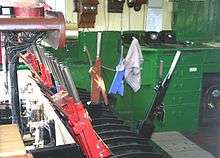Rule 55
Rule 55 was an operating rule which applied on British railways in the 19th and 20th centuries, and which was superseded by the Modular Rulebook following re-privatisation of the railways. Its principle survives: waiting trains on running lines must remind the signal controller (signaller) of their presence.
Overview

Rule 55 was introduced following a spate of accidents caused by signalmen forgetting that trains were standing on a running line, sometimes within sight of their signal boxes.
It required that, if a train was brought to a stand at a signal, within three minutes in clear weather or immediately in rain, snow, or fog, the driver of the train must despatch his fireman, guard, or any shunter riding on the train, to the signal box to ensure that the signalman was aware of the presence of the train, and that all safeguards to protect it, such as slides or collars on the signal levers, were in place, the crewman then signing the train register to confirm this.
In practice, this meant a cautious trudge, in whatever weather, for the crewman (although there was usually a mug of tea to be had in the signal box). Occasionally the rule was obeyed to the following extent: the crewman merely exchanged a greeting with the signalman, signed the register and returned to the train. In many cases, such as at major junctions or marshalling yards where crewmen crossing the rails were in grave danger from moving trains, the rule could not be applied properly (see exemption white diamond pictured). Further, the need for the fireman to return to the train would delay it if the signal was cleared in the meantime.
Accidents
Failure to apply the rule properly was a factor in several railway accidents in the period from 1890 onwards. At Thirsk and Hawes Junction, the crews of the standing trains failed to carry out the rule. At Quintinshill, the fireman of the standing train signed the register but did not ensure that the signalman had put the necessary safeguards in place.

It is impossible to know precisely how many accidents were prevented by the proper observation of the rule, and it could not always prevent a crash. At Winwick, a train was brought to a stand some distance from the signal box. The fireman left promptly to carry out the rule, but he had not reached the signal box before his train was struck. To prevent such occurrences, 'call plungers' (which operate an indicator in the signal box when pressed) or telephones were installed at some signal posts, or track circuits installed. However, even this solution was not completely foolproof e.g. at Castlecary in 1937, the signalman observed that a train had passed a signal at danger, possibly due to a false signal indication, and assumed it had continued on past his signal box. The signalman failed to check his track circuit indicators, which would have shown that the non-cleared train stopped, and the fireman arrived in the signal box moments too late to stop the signalman accepting a following express train. Full interlocking with track circuits and signal indications may have prevented this accident.
Exemption
A white diamond sign on a signal post indicated to the driver that Rule 55 did not apply at that signal (at which no telephone was provided), due to the train being protected by track circuits, axle counter or similar means.
Modernised rule
The basic principle of Rule 55 remains today. It has been updated as it is usually unnecessary for train crew to visit the signal box, as most of the rail network is track circuited and modern technology such as signal post telephones, in-cab radio, and mobile phones [1] allows instant communication.
In the modern rulebook, rules are defined by the module and section in which they are located.
In this case it is Module S4, section 1:[2]
Driver - When your train is detained at a signal at danger on a running line, you must remind the signaller.Except as otherwise shown in this module, you must contact the signaller as soon as possible.
However, you can wait for up to two minutes before contacting the signaller if you can see an obvious reason for the signal to be at danger such as:
- the section ahead being occupied by a train
- a conflicting movement being made at a junction.
References
- Rolt, L.T.C. Red for Danger. Pan. ISBN 0-330-25555-X.
- ↑ Mobile phones are authorised for contacting the signaller. GE/RT8000 Rule Book Module S4 Section 2.3 (PDF).
- ↑ Railway Group Standards. GE/RT8000 Rule Book Module S4 Section 1 (PDF).